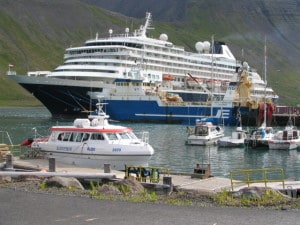Well the weather gods were with us, as far as the wind was concerned. By the time we started our sightseeing, the fog had been blown away and then the wind started to die down. Good for sightseeing and good for docking later on. Isafjordur is located in a deep bay with several inlets. It looks a bit like a cats paw when seen on the chart. This area is called the Isafjardjup fjord and we made a slow sail by through this fjord. The whole area is of volcanic origin and the mountain ridges all have slopes where debris has accumulated. Rocks that have come loose because of the extreme temperature differences between summer and winter that can occur. Also water that froze in the cracks during the winter months and then expands caused large and small pieces of rock to breakaway from the solid part. I found it looking a bit like Idaho, as long as you forgot about the Greenery.
By 10.30am we started approaching the port itself, named after the little fjord at which end it is located. The fact that the wind died down to nothing, now made my day. The port of Isafjodur is small, very small. But they have a big dock and thus we wanted to dock there. The challenge is that the area around the dock is shallow. You have to swing off the berth and stay right on top of it or swing outside and go stern way in. By the time that you are then alongside you have about 30 feet to the shallows forward and 45 feet to the shallows aft. On a length of nearly 700 feet of ship that is not so much. With no wind, I opted for the swing at the dock because as long as there is no wind, the Prinsendam does not drift and then I can keep her “on the inch” in position while making the 180o swing. Had it been windy then I would have swung outside the port. But when coming astern it is harder to stop the ship on time and not to overshoot, certainly when the wind is pushing you astern as well.
 The Prinsendam during last years call. Capt. Albert Port database
The Prinsendam during last years call. Capt. Albert Port database
So we swung off the dock and were happily alongside a nice pier called Sundabakki. I have to profess that I have no idea what that means. The pilot that came onboard was a man with many talents. He was the head pilot, the ships agent, the water man, the garbage man and he also acted as the local authority for clearing the ship. The latter is nowadays not much of a problem any more; everything is done beforehand by email. At least in most European country’s. The rest of the world can be a very different story. The town came to prominence in the 18th century as a home port for the whaling ships until the outright ban for whaling came in existence in 1989. Now there is talk again about restarting commercial whaling and the town is very much divided on this subject. There are those who see commercial opportunities, especially now Iceland is in deep recession due to the banking scandal, and there are those who do not see the need at all for killing whales as the town survived without it for 30 to 40 years.
We did not see any whales while we approached and departed from Isafjordur at all. We did spot a few while coming South to Iceland, so it seems that they do not come very close to coastal waters here. We only had a short afternoon stop in this port as there is only so much you can do in a small town like this. It remained dry but it was very cold especially later in the afternoon when a moderate North easterly breeze started to blow. A breeze that came down into the fjord via a glacier further up North. A sort of natural air conditioning that we really did not need.
Tomorrow we are in Reykjavik, the capital of Iceland, and I am wondering what that day will bring. I have three different weather forecasts on my desk and it will depend on what a front system South of Iceland is going to do, to see which one will be correct. I am gambling at the moment on an overcast day but with diminishing winds.

August 2, 2009 at 5:39 pm
Captain, Thank you for posting this blog. I love to read about the different
issues you are faced with while docking and controlling your ship